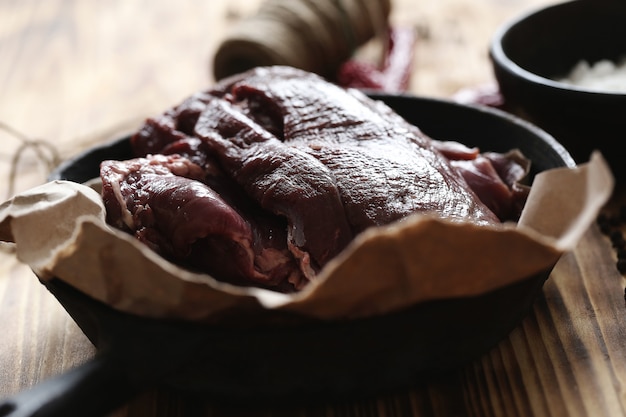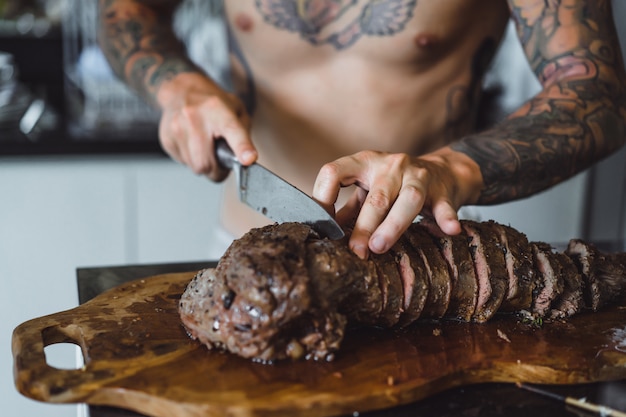(Part 1) Choosing the Right Steak

First things first, you need to choose a steak that’s going to be juicy and flavorful, not something tough and chewy. I'm talking about a cut that’s going to melt in your mouth, not make you work for it.
My personal favourites are ribeye, sirloin, and new york strip. They're all marbled with fat, which adds flavor and tenderness. The fat renders during cooking, basting the steak and creating a beautiful, juicy texture.
But don't be afraid to experiment! You might discover a new favourite. filet mignon, with its buttery tenderness, is a classic choice, and flank steak, with its unique flavour, is perfect for those who like a leaner option.
When you're at the butcher’s counter, look for a steak that's about 1 inch thick. This will ensure it cooks evenly and doesn't dry out. Also, check the colour – the meat should be a bright, deep red colour, not dull or brown.
Once you've got your steak, it's time to get ready for cooking!
(Part 2) Preparing the Steak

Before you even think about firing up the oven, you need to prepare your steak properly. It's all about those little details that make a big difference.
First, give the steak a good pat dry with some kitchen paper. You want the surface to be as dry as possible so it gets a good sear. And don't forget to season it generously with salt and pepper. I always like to add a little bit of garlic powder and paprika for extra flavour. You can also try a pinch of smoked paprika for a deeper, smokier taste.
Now, here's a little trick I've learned over the years: let the steak sit at room temperature for about 30 minutes before cooking. This will allow the meat to warm up and cook more evenly. This is especially important for thicker cuts of steak.
With your steak prepped and ready to go, it's time to get that oven nice and hot!
(Part 3) Getting the Oven Ready

A lot of people will tell you that you need a super fancy grill to get that perfect sear, but trust me, your trusty oven can do the trick just as well!
Pre-heat your oven to a scorching 450°F (232°C). Yes, I mean scorching! You want that oven to be piping hot to achieve that beautiful crust on the outside and that juicy, pink centre on the inside.
You can use a baking sheet or a cast iron skillet, whatever you have on hand. A cast iron skillet will absorb the heat better, which helps to achieve a more consistent sear. But be sure to grease it well to prevent the steak from sticking.
While the oven is pre-heating, it's a good time to check your kitchen timer and get those side dishes ready. Roasted vegetables, mashed potatoes, or a simple green salad are great companions for your steak.
(Part 4) The Initial Sear
Okay, here's where the fun begins! With your oven roaring hot and your steak prepped, it's time to sear that bad boy.
Place the steak directly on the hot baking sheet or skillet and cook for about 2-3 minutes per side. You want to see a beautiful brown crust forming. You'll hear that lovely sizzle as the steak hits the hot surface, and that's the sound of perfection in the making.
Remember, don't move the steak around too much during the sear. You want to give it a chance to develop a nice crust without getting disturbed.
After you've seared both sides, it's time to move on to the next stage – cooking it to perfection in the oven.
(Part 5) Oven Time
Now, this is where the real magic happens.
Take your beautifully seared steak and transfer it to the oven. Set the timer for about 10-12 minutes for a medium-rare steak.
Now, this is the tricky part – you need to keep an eye on the steak while it's cooking. You can use a meat thermometer to check the internal temperature, but I prefer to go by feel.
Here's a little tip: when you press the steak with your finger, it should feel firm, but not rock hard. It should have a bit of give, like a well-done marshmallow.
Keep in mind that the steak will continue to cook even after you take it out of the oven, so it's best to take it out a little bit early. Aim for an internal temperature about 5°F lower than your desired doneness.
Once you're happy with the doneness, it's time to give your steak a well-deserved rest.
(Part 6) Letting the Steak Rest
You've come this far, so don't rush the final step! Let the steak rest for 10-15 minutes before slicing and serving.
Why? Because resting allows the juices to redistribute throughout the steak, resulting in a more tender and flavourful final product. The juices that have been pushed to the surface will be reabsorbed during this time, preventing them from running out when you slice it.
While the steak is resting, you can prepare the rest of your meal. I love serving my steak with roasted vegetables, mashed potatoes, or a simple green salad.
(Part 7) Slicing and Serving
Finally, the moment of truth!
Slice your steak against the grain. This will make it easier to chew and more tender. The muscle fibres in the steak run in a specific direction, and slicing against them allows the knife to cut through them more easily.
Serve it with your favourite sides and enjoy!
I like to drizzle a little bit of steak sauce on top, but that's just my personal preference. Some people prefer a good dollop of butter or a sprinkle of herbs.
(Part 8) Understanding Doneness
Here's a handy table that will help you understand the different levels of doneness:
| Doneness | Internal Temperature (°F) | Internal Temperature (°C) | Description |
|---|---|---|---|
| Rare | 125-130 | 52-54 | Cool red centre, warm outer ring |
| Medium-Rare | 130-135 | 54-57 | Warm red centre, pink throughout |
| Medium | 140-145 | 60-63 | Pink centre, brown outer ring |
| Medium-Well | 150-155 | 66-68 | Slightly pink centre, mostly brown |
| Well-Done | 160 | 71 | Completely brown, no pink |
Remember, these are just general guidelines. The ideal temperature for your steak will depend on your personal preference and the thickness of the cut. If you're unsure, it's always best to err on the side of undercooking. You can always cook it a little bit longer, but you can't uncook it!
(Part 9) FAQs
1. What if my oven doesn't get that hot?
Don't worry! If your oven doesn't reach 450°F, you can still get a good sear. Just cook the steak for a couple of extra minutes per side. You can also try using a cast iron skillet on the stovetop for the initial sear.
2. Can I cook my steak from frozen?
It's best to cook your steak from thawed. This will ensure it cooks evenly. Freezing and thawing can affect the texture of the meat, making it more likely to be tough.
3. What if my steak is thinner than 1 inch?
If your steak is thinner, you'll need to adjust the cooking time accordingly. Just make sure to keep a close eye on it so it doesn't overcook. You might want to reduce the oven temperature slightly to avoid burning the thinner steak.
4. What are some good side dishes to serve with steak?
There are so many amazing side dishes to choose from! Some of my favorites are roasted vegetables (think Brussels sprouts, asparagus, or bell peppers), creamy mashed potatoes, a simple green salad with a vinaigrette dressing, or even a potato gratin.
5. How can I tell if my steak is done without a meat thermometer?
You can use the finger test! Press the steak with your finger. If it feels firm but not rock hard, it's medium-rare. If it feels springy, it's medium. If it feels very firm, it's medium-well.
And there you have it, my complete guide to cooking the perfect medium-rare steak in your oven! Now go forth and conquer, my friend! Remember, practice makes perfect, so don't be afraid to experiment and find what works best for you.
Everyone is watching

How to Cook Frozen Lobster Tails Perfectly: A Step-by-Step Guide
RecipesLobster. Just the word conjures up images of lavish meals, special occasions, and a taste of luxury. But let's...

Pigs in a Blanket Cooking Time: How Long to Bake for Perfect Results
RecipesAh, pigs in a blanket. Just the name conjures up images of those delightful little parcels of crispy pastry en...

Pork Fillet Cooking Time: How Long to Cook It Perfectly
RecipesPork fillet, or tenderloin as it's sometimes called, is a real favourite in our house. It's so versatile, and...

The Ultimate Guide to Cooking Delicious Frankfurters
RecipesLet's face it, we all love a good frankfurter. It's a classic, simple, and always satisfying. But let's be rea...

Wolf Meat Recipes: A Guide to Cooking Wild Game
RecipesLet's be honest, you don't see wolf meat at your local butcher shop every day. It's a bit of a wild card, but ...
